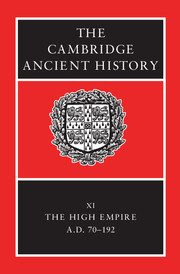Book contents
- Frontmatter
- PART I NARRATIVE
- PART II GOVERNMENT AND CIVIL ADMINISTRATION
- PART III THE EMPIRE
- 8 Frontiers
- 9 The army
- 10 Local and provincial institutions and government
- 11 Rebels and outsiders
- PART IV ROME, ITALY AND THE PROVINCES
- PART Va ECONOMY AND SOCIETY
- PART Vb ART AND CULTURE
- Chronological Table
- BIBLIOGRAPHY
- Index
- 1 The Roman world in the time of Marcus Aurelius
- 7 The Danube provinces
- References
9 - The army
from PART III - THE EMPIRE
Published online by Cambridge University Press: 28 March 2008
- Frontmatter
- PART I NARRATIVE
- PART II GOVERNMENT AND CIVIL ADMINISTRATION
- PART III THE EMPIRE
- 8 Frontiers
- 9 The army
- 10 Local and provincial institutions and government
- 11 Rebels and outsiders
- PART IV ROME, ITALY AND THE PROVINCES
- PART Va ECONOMY AND SOCIETY
- PART Vb ART AND CULTURE
- Chronological Table
- BIBLIOGRAPHY
- Index
- 1 The Roman world in the time of Marcus Aurelius
- 7 The Danube provinces
- References
Summary
When Trajan decided at the beginning of the second century to create a new legion it was accorded two titles, Ulpia after the family name of its creator, and victrix – ‘the Victorious’ – an epithet to which the legion might hopefully aspire; numerically it was to be known as the Thirtieth, for there were now thirty legions in the empire. As will be shown below, the theoretical strength of each legion was, including officers, something over 5,300 men, so the total number of soldiers at the beginning of the second century serving in this branch of the Roman army was about 160,000 men.
Yet the army that pushed back the borders of the empire under Trajan, and then took on the task of defending them under Hadrian and his successors, did not consist of legions alone. There were, in addition, the auxiliary regiments recruited mainly from the frontier provinces of the empire. The soldiers in these units were less well paid and less thoroughly trained than the legionaries and unlike them they did not, for the most part, possess Roman citizenship, but, for all that, they were a vital element in the defence of the empire and its wars of expansion. The size of these regiments differed from that of the legions, for they consisted at most of a theoretical 1,000, more often only half that number. In terms of total manpower, however, they outnumbered the legions by a figure that lay somewhere between a third and half as much again, so that, all told, the Roman army may have consisted of some 380,000 men.
- Type
- Chapter
- Information
- The Cambridge Ancient History , pp. 320 - 343Publisher: Cambridge University PressPrint publication year: 2000
References
- 12
- Cited by

